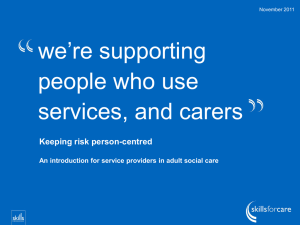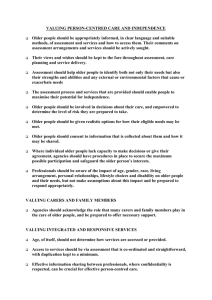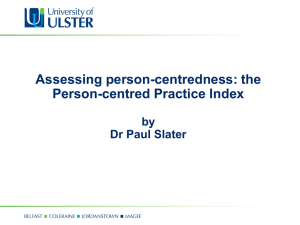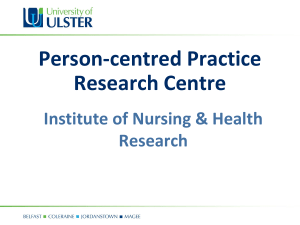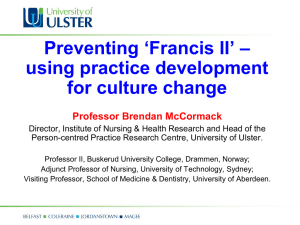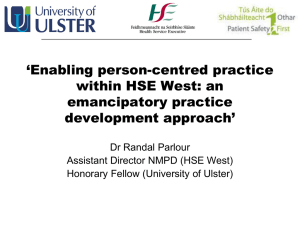Person-centred care made simple
advertisement
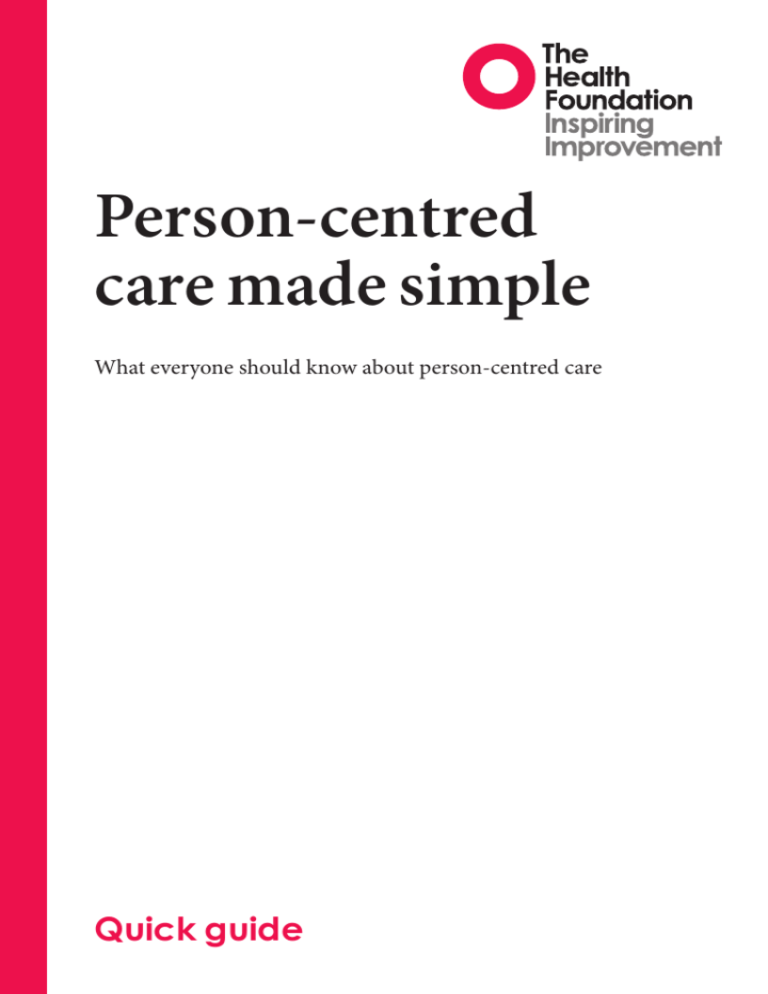
Person-centred care made simple What everyone should know about person-centred care Quick guide ABOUT THE HEALTH FOUNDATION The Health Foundation is an independent charity working to improve the quality of health care in the UK. We are here to support people working in health care practice and policy to make lasting improvements to health services. We carry out research and in-depth policy analysis, fund improvement programmes to put ideas into practice in the NHS, support and develop leaders and share evidence to encourage wider change. We want the UK to have a health care system of the highest possible quality – safe, effective, person-centred, timely, efficient and equitable. Person-centred care made simple October 2014. © 2014 Health Foundation ISBN 978-1-906461-56-0 CONTENTS 1 2 3 4 5 6 7 Introduction2 What is person-centred care? 5 Why is person-centred care so important? 10 How has person-centred care developed? 13 Putting person-centred care into practice 16 Frequently asked questions 24 Where can I find out more? 31 References35 INTRODUCTION 1 The challenges facing the NHS are well understood. There are growing numbers of older people and people living with long-term conditions and disabilities. At the same time, health and social care budgets are under increasing pressure. If we are to provide high quality care that affords people the best possible quality of life, we need to rethink the relationship between people and the services that provide their care. In person-centred care, health and social care professionals work collaboratively with people who use services. Person-centred care supports people to develop the knowledge, skills and confidence they need to more effectively manage and make informed decisions about their own health and health care. It is coordinated and tailored to the needs of the individual. And, crucially, it ensures that people are always treated with dignity, compassion and respect. This might seem a common sense vision for any form of health care, but it is not standard practice. Often, health care does ‘to’ or ‘for’ people rather than ‘with’ them, finds it difficult to include people in decisions, and views people’s goals only in terms of particular clinical outcomes. 3 Adopting person-centred care as ‘business as usual’ requires fundamental changes to how services are delivered and to roles – not only those of health care professionals, but of patients too – and the relationships between patients, health care professionals and teams. Despite the challenges in making this shift, personcentred care does exist, in a modest but growing number of services, with positive outcomes. It requires effort, but it certainly is possible. This guide seeks to provide a quick overview of personcentred care. It is written for anyone interested in health and health care, including health care professionals and those who use the NHS. 4 WHAT IS PERSONCENTRED CARE? 2 5 The term ‘person-centred care’ is used to refer to many different principles and activities, and there is no single agreed definition of the concept. This is partly because person-centred care is still an emerging and evolving area. It is also because, if care is to be person centred, then what it looks like will depend on the needs, circumstances and preferences of the individual receiving care. What is important to one person in their health care may be unnecessary, or even undesirable, to another. It may also change over time, as the individual’s needs change. Instead of offering a concise but inevitably limited definition, the Health Foundation has identified a framework that comprises four principles of person-centred care:* 1 Affording people dignity, compassion and respect. 2 Offering coordinated care, support or treatment. 3 Offering personalised care, support or treatment. 4 Supporting people to recognise and develop their own strengths and abilities to enable them to live an independent and fulfilling life. * For more information about these principles, see Dr Alf Collins’ thought paper for the Health Foundation, Measuring what really matters. Available from: www.health.org.uk/publications/measuring-what-really-matters 6 Figure 1: The four principles of person-centred care of person-centred care The four principles is t at s si re wi spect Care is... enabling , re P ers o n ed Care is... coordinated on Care is... personalised t h .. . d i g nit y , c o a mp Whatever the specific care or interventions a person receives, it should be done with these principles in mind. Any example of person-centred care, within any health care experience, will involve a combination of these principles. If the person is highly dependent – for example, if they are unconscious or otherwise lack capacity – there is likely to be more emphasis on the principles of dignity, compassion and respect, coordination and personalisation. However, even in these cases it is usually possible to practise all four principles to some extent. 7 A NEW RELATIONSHIP The principle of being enabling is rather different from the others. A health care provider could feasibly uphold the other three principles without the person’s input. They could work on behalf of the population they serve to ensure that people are treated with dignity and receive services that are better coordinated and personalised to fit around their needs. But for care to be enabling, the relationship between health care professionals and patients needs to be a partnership rather than the professional being the expert while the patient simply follows their instructions. It is a relationship in which health care professionals and patients work together to: –– understand what is important to the person –– make decisions about their care and treatment –– identify and achieve their goals. Health care professionals, health and care workers, peer support workers and others, have a role in supporting people to develop the knowledge, skills and confidence they need to fully participate in this partnership. 8 TERMINOLOGY Because the concept of person-centred care is new and developing, you may have come across a range of other terms also used to refer to similar principles and activities. Examples include patient-centred care, personalisation, relationship-centred care and, in Scotland, mutuality. In this guide, we refer to ‘person-centred care’ throughout. We use the word ‘person’ in order to emphasise a holistic approach to care, that takes into account the whole person – not a narrow focus on their condition or symptoms but also their preferences, wellbeing and wider social and cultural background. 9 WHY IS INTRODUCTION PERSON-CENTRED CARE SO IMPORTANT? 1 3 Given the current focus on safety and financial targets, some might ask whether person-centred care is a ‘nice to have’ rather than an essential – or at least a lower priority. However, if we turn this thinking around then, according to the four principles (see page 6), are we saying it is acceptable for health care to: –– fail to offer people dignity, compassion or respect? –– be poorly coordinated? –– treat patients as a set of diagnoses or symptoms, without taking into account their wider emotional, social and practical needs or those of their carers? –– maintain dependency, so that patients fail to recognise and develop their own strengths and abilities and live an independent and fulfilling life? Obviously, most people would answer ‘no’ to these questions. However, in addition to the clear ethical rationale, there are also some very practical reasons for adopting person-centred care. Many people want to play a more active role in their health care, and there is growing evidence that approaches to person-centred care such as shared decision making and self-management support can improve a range of factors, including patient experience, care quality and health outcomes. Examples include the following: –– Supporting patients with long-term conditions to manage their health and care can improve clinical outcomes.1 When people play a more collaborative role in managing their health and care, they are less likely to use emergency hospital services.2 They are also more likely to stick to their treatment plans3 and take their medicine correctly.4 11 –– Patients who have the opportunity and support to make decisions about their care and treatment in partnership with health professionals are more satisfied with their care,5 are more likely to choose treatments based on their values and preferences rather than those of their clinician,6 and tend to choose less invasive and costly treatments.7 –– Individuals who have more knowledge, skills and confidence to manage their health and health care are more likely to engage in positive health behaviours and to have better health outcomes.8 –– Person-centred care is good for health care professionals too. As patient engagement increases, staff performance and morale see a corresponding increase.9 Care that is person-centred should also represent better value for money because it ensures that services are built on the needs and preferences of the people who use them, rather than on the convenience of providers. Person-centred care and, in particular, approaches such as collaborative care and support planning and self-management support (see Section 5) can also help services respond to the needs of the growing number of people living with long-term conditions. 12 INTRODUCTION HOW HAS PERSONCENTRED CARE DEVELOPED? 14 13 In the early 1960s, psychologist Carl Rogers was the first to use the term ‘person-centred’, in relation to psychotherapy (and had used ‘client-centred’ as early as the 1950s). Although different in many ways from today’s meaning of ‘person-centred care’, a key element that both approaches share is empathy – the professional’s willingness to suspend judgement and appreciate the service user’s perspective. Rogers termed this ‘unconditional positive regard’. In the late 1970s, American psychiatrist George Engel promoted the move from a medical to a biopsychosocial model of health – a model that is now commonly used to explain the shift required to deliver person-centred care. These ideas began to become aligned within health care in the 1990s in the US, when the Chronic Care Model was developed to address perceived deficiencies in how people with long-term conditions were supported. And in 2001, the highly influential Institute of Medicine included ‘patient-centredness’ as one of its six aims of health care quality.10 Over the following decade, ideas of person-centredness began appearing with increasing regularity in UK health policy. The 2000 NHS Plan highlighted the need for personalisation and coordination,11 while in 2002 the Wanless report focused on enablement and empowerment, with patients as partners in care.12 In 2008, Lord Darzi’s report High quality care for all described changing public expectations of services, including the importance of people being involved in decisions about their care.13 14 The following year, the first NHS Constitution in England set out what people could expect the NHS to deliver, pulling together all of these policy statements of intent into a rights framework. It stated that ‘NHS services must reflect the needs and preferences of patients, their families and their carers. Patients, with their families and carers where appropriate, will be involved in and consulted on all decisions about their care and treatment.’ This has been further strengthened in subsequent versions.14 Since 2010, the Francis inquiries into failings in care at Mid Staffordshire NHS Foundation Trust between 2005 and 2009 have propelled person-centred care back into the spotlight, focusing on dignity, compassion and respect.15 And in 2013, the Berwick Advisory Group argued for ‘greater involvement of patients and their carers at every level of the health service in order to deliver safe, meaningful and appropriate health care’.16 Today, person-centred care is also central to the policies of the four UK countries. The Health and Social Care Act 2012 imposes a legal duty for NHS England and clinical commissioning groups (CCGs) to involve patients in their care.17 Vision 2020 for Scotland has a focus on supported self-management.18 Northern Ireland’s 2020 quality strategy cites ‘patient and client focus’ as one of its three main areas of focus,19 while the Welsh White Paper The listening organisation focuses exclusively on ‘ensuring care is person-centred in NHS Wales’.20 More information Our interactive timeline provides a visual guide through the key events that have contributed to the move towards a more person-centred health service over the past 50 years. Find the timeline at: www.health.org.uk/pcctimeline 15 PUTTING PERSONCENTRED CARE INTO PRACTICE 5 16 In order to make health care more person-centred, services and practitioners need to be open to a wide range of approaches and initiatives. This section presents some examples of work that is being done, with the aim of providing inspiration and helping those who are looking to put person-centred care into practice. The section includes a combination of broad approaches, specific initiatives and quality improvement approaches. Some of these seek to improve the care or experience of individual patients while others focus on making care more person-centred at an organisational or wider level. Collaborative care and support planning A way of supporting people with long-term conditions and disabilities to work together with their health care professionals to plan their care. The process involves exploring what matters to the person; identifying the best treatment, care and support; and supporting them to set goals and think about actions they can take to reach them. The charity National Voices has developed an interactive guide to four stages of the approach: –– preparing for a discussion –– having the discussion (with the care and support partner) –– writing down the main points from the discussion –– review. Find out more: www.nationalvoices.org.uk/what-care-and-supportplanning 17 Experience-based co-design A method for improving people’s experience of health care that involves gathering experiences of patients and staff and then bringing them together to develop service improvements. This evidence-based method was developed by academics at King’s College London and has been tested at sites internationally. The approach helps staff to re-frame what they do, to see things from patients’ perspectives, and to work with patients to identify often small changes that make a big difference to patients’ experience of care. Find out more: www.kingsfund.org.uk/ebcd Hello, my name is... A national campaign founded by Kate Granger, a doctor living with terminal cancer, to encourage all staff to introduce themselves by name and profession when meeting a new patient. Kate says, ‘In my mind it is the first rung on the ladder to providing compassionate care.’ Find out more: www.hellomynameis.org.uk 18 House of Care A model that draws on international evidence and best practice to show that effective care planning relies on four key elements in the local health care system: –– Patients feeling engaged in decisions about their treatment and care and able to act on these decisions. –– Professionals being committed to working in partnership with patients. –– Systems being in place to organise resources effectively. –– Having a whole-system approach to commissioning health and care services. The House of Care illustrates the importance and interdependence of each element: if one element is weak or missing, the structure is not fit for purpose. The model can act as: –– a checklist – highlighting what needs to be in place –– a metaphor – emphasising that care and support planning is complex and that all the components need to be in place to make it a success –– a flexible framework – guiding each local community to build a stable house designed round the needs of local people. Find out more: http://coalitionforcollaborativecare.org.uk/house-of-care 19 Person and family-centred care A quality improvement process that focuses on two parallel aspects of health care: care processes (the way care is organised) and staff interactions with patients and their families (human interactions). This evidence-based approach incorporates ‘shadowing’ patients, developing a shared vision for the ideal patient experience, and working through individual improvements. A toolkit provides case studies, guidance on each step and improvement tools to use through the process. Find out more: www.kingsfund.org.uk/projects/PFCC; www.health.org.uk/areas-of-work/programmes/ family-patient-centred-care Personal health budgets/individual budgets A system that enables people to manage their care in the way that suits them best. They are used in North America, Australasia, Scandinavia and much of Western Europe. The individual designs and agrees a plan with their health care team that helps them meet their goals. They then receive a ‘budget’ to spend on their care. Some receive this directly, while for others, it takes the form of a nominal budget or is managed by a third party. 20 People may choose to spend their budget on things that enhance their health and wellbeing but are not traditionally considered health care, such as gym membership or a companion to allow them to go on outings. Find out more: www.personalhealthbudgets.england.nhs.uk; www.selfdirectedsupportscotland.org.uk/directing-yourown-support Schwartz Rounds An approach designed to help providers of health and social care develop their organisational culture and support staff by allowing time for staff reflection and sharing insights. The ‘rounds’ bring together professionals to share lunch and then explore a workplace event, such as an incident involving a particular patient, or a theme, such as ‘when things don’t go to plan’. These often focus on non-clinical aspects of care. One team gives a short presentation on their experience and then their colleagues share thoughts and similar experiences, moderated by trained facilitators. A range of benefits have been documented, including staff becoming more empathetic, more confident in handling sensitive issues and non-clinical aspects of care, and more open to expressing thoughts, questions and feelings. Find out more: www.pointofcarefoundation.org.uk/schwartz-rounds 21 Self-management support A whole-system approach to enabling people with long-term conditions to manage their health on a day-to-day basis. Every day, anyone living with long-term conditions will make decisions, take actions and manage a broad range of factors that contribute to their health. Self-management support acknowledges this, and supports people to develop the knowledge, skills and confidence they need. For people with long-term conditions, self-management support may include structured group education programmes, health coaching or motivational interviewing. Health care professionals also need to develop the skills, knowledge and confidence to support patients – for example, through training in agenda setting, goal setting and goal follow-up. Services also need to be organised differently to make sure that people really do receive the support they need – for example, changing IT systems to enable people to receive their test results before their appointment. Find out more: http://personcentredcare.health.org.uk/person-centredcare/self-management-support Shared decision making A collaborative process through which a health care professional supports a patient to reach a decision about a specific course of action, such as deciding on a strategy to manage the pain from knee arthritis. 22 The conversation brings together the health care professional’s expertise – such as the treatment options, risks and benefits – with the areas that the patient knows best: their preferences, personal circumstances, social circumstances, goals, values and beliefs. This approach can be useful whenever a decision is needed. It can help prepare individuals before a consultation by encouraging them to think about the questions they want to ask. It often involves decision support materials designed to help individuals weigh up their options, such as information resources, patient decision aids, brief decision aids and option grids. Find out more: http://personcentredcare.health.org.uk/person-centredcare/shared-decision-making ‘What matters to me’ boards An information board placed above beds to make sure everyone can see what is most important to each patient. The magnetic boards are used to write down patients’ preferences and priorities, such as whether they want friends and family close by, or preferences about pain relief, sleep or treatment options. The boards help share information that may not always be included at handover and act as a talking point to help staff get to know patients better. They were developed as part of Salford Royal NHS Foundation Trust’s quality improvement strategy and are used in all wards at Salford Royal Hospital. Find out more: www.srft.nhs.uk/about-us/quality/what-matters-to-me 23 FREQUENTLY ASKED QUESTIONS 6 What kinds of changes are possible through person-centred care? Person-centred care can be used to improve any aspect of health care, from making an appointment to making decisions about palliative care. Person-centred care has been used to improve quality of health care in a range of ways – for example, to: –– reduce the number of complaints and improve the admissions process in a secure psychiatric unit21 –– negotiate a treatment plan for people with recurrent mental health problems, working with them during a well period to plan for how their treatment should look when they are less able to choose22 –– support people living with conditions such as diabetes, chronic obstructive pulmonary disease (COPD), depression and long-term pain to become more effective self-managers through structured education, training for health care professionals and improving organisational processes23 –– support women to decide whether to have a mastectomy or breast-conserving surgery, and men with enlarged prostate to decide whether to take drugs, have surgery or make lifestyle changes24 –– enable dialysis patients to carry out as many of the 13 steps to managing their own hospital treatment as they felt comfortable with25 –– support mental health service users through employing peer support workers (people with lived experience of mental health problems) as part of the health care team to provide practical, physical and emotional support to individuals, contributing to a significant reduction in inpatient stays amongst the people they worked with.26 25 Can we afford person-centred care? Any health care system needs to make sure that its resources are targeted in a way that will produce positive outcomes. This is especially the case when budgets are under pressure. By taking a person-centred approach, health care professionals can ensure that they are not prescribing medication that patients will not take, referring them for services they will not engage with or surgery that they would prefer not to have. In other words, taking any course of action without ensuring that it is line with a patient’s preferences and priorities is potentially a waste of time and financial resources.27 Currently, 70% of health and care spending goes towards treatment and care of the estimated 18 million people in the UK with long-term conditions. So the real question is: can we afford not to look at different ways to organise services in order to achieve maximum value? Person-centred care ensures that resources are spent on what really matters to people. Does person-centred care save money? There is evidence about cost savings and reductions in service use related to person-centred care activities. For example: –– when people are better informed they may choose different treatments – often those that are less invasive and less expensive28,29 26 –– people who are supported to manage their own care more effectively are less likely to use emergency hospital services30 –– people who take part in shared decision making are more likely to stick to their treatment plan and to take their medicines correctly.31 Person-centred care can also help address the health care demands of our ageing population and the huge growth in long-term conditions, many of which can be ameliorated through lifestyle changes, such as improvements to diet. These, by their very nature, can be effective only if they focus on the things that matter to people. By enabling patients to make choices about what they want, person-centred care helps create better value for money, ensuring that what we do spend goes towards those things that patients value most. Does person-centred care take longer? Person-centred care comprises not only a whole range of tools and activities, but a mindset that values and supports patients to be partners in their care. Taking a simple approach such as ‘Hello, my name is’ (see page 18) – introducing oneself by name to a patient – would not take any longer, but might make a big difference. On the other hand, adopting a personcentred approach through an activity such as shared decision making may take longer than a standardlength consultation in the short term. However, if the standard-length consultation results in a prescription for medication that the person finds difficult to fit around their routine, resulting in non-adherence, worsening symptoms and further consultations down the line, we can see that the notion of time taken is not necessarily straightforward. 27 How can we tell if care is person centred? There is no single, off-the-shelf solution to measuring whether care is person centred.† Because personcentred care comprises a combination of activities that depend on the patient and situation in question, measuring the degree to which it is happening can be challenging. What is person centred for one person may not be for someone else. A person-centred approach means focusing on the elements of care, support and treatment that matter most to the patient, their family and carers. So before even thinking about measuring, the priority is to identify what is most important to them, without making assumptions. For example, organisational data may identify that patients are waiting too long in outpatients, but other sources may reveal that patients are more concerned about a lack of information during their wait rather than the overall length of the wait. The starting point is to consider an experience of care (say, a visit to the outpatients clinic or being admitted for surgery) in terms of the four principles described in Section 2, and assessing the extent to which the care demonstrates each of the principles. This requires a range of information, including quantitative and qualitative data, such as personal stories. It is also vital to monitor and respond to feedback mechanisms, such as complaints and patient surveys (real-time local feedback and national surveys), which sit alongside measurement. † Our recent evidence review, Helping measure person-centred care, summarises research about measuring the extent to which care is person centred and highlights commonly used approaches and tools to do so (www.health.org.uk/helpingmeasurepcc). However, it is an evolving area and Alf Collins’ thought paper, Measuring what really matters, explores what needs to happen to develop a coherent measurement system for person-centred care (www.health.org.uk/publications/measuring-what-really-matters). 28 What are the barriers and enablers of person-centred care? There are many factors, at all levels of the health system, that can act as barriers or enablers to developing and embedding person-centred care in mainstream health care. At a national level there are a number of levers, such as payment systems, that may support or hinder personcentred care in practice. Within health services, organisational processes and systems can also affect attempts to implement person-centred care. For example, can IT systems support people being sent test results and other information in advance of their appointment? More fundamentally, organisational culture can have a big influence on whether teams and individuals feel motivated and able to work in a person-centred way. Support and buy-in from senior leaders, acting as champions for change, can have a powerful effect. Encouraging and empowering staff to change services locally, rather than imposing solutions, and bringing together a core team to drive change can also really help. In addition, individuals’ personal characteristics can affect the extent to which they want or are able to engage in their health and care. These characteristics include their social and cultural background, their health status or condition and their beliefs and preferences. It is important to take into account these factors when designing interventions and approaches. 29 For health care professionals, a commonly cited barrier is that many believe the care they provide is already person-centred. However, the evidence shows that this is often not the case.32 Techniques such as Experience-based co-design (see page 18) and Person and family-centred care (see page 20), as well as practical training in self-management support and shared decision making (see page 22) can help open professionals’ eyes to the gap between what they believe patients experience and what patients say they actually experience. Ultimately, all levels of the health system, including local and national policy, organisational leadership and management, and individual health professionals, patients and service users, have a role to play in creating the right conditions and circumstances for personcentred care to flourish. 30 WHERE CAN I FIND OUT MORE? 7 31 1000 Lives Plus The Welsh national improvement programme, supporting organisations and individuals to deliver the highest quality and safest health care for the people of Wales. www.1000livesplus.wales.nhs.uk/pp-driven-care 6Cs An initiative developed in response to the Chief Nursing Officer of England’s Compassion in Practice strategy and vision, which refers to what it calls the ‘6Cs’: –– care –– compassion –– courage –– commitment –– competence –– communication.33 6Cs Live! is working to promote these six areas of action by aligning tools, techniques and examples of good practice and making them easily accessible. It also provides a virtual communications hub where nurses, midwives and care staff can share learning and solutions in order to improve quality of care, make service improvements and celebrate success. www.england.nhs.uk/nursingvision/6cslive Coalition for Collaborative Care A group of organisations across the health, social care and voluntary sectors working to improve the relationships that people have in their day-to-day interaction with the NHS and social care so their care and support is organised around what matters to them. http://coalitionforcollaborativecare.org.uk 32 Health Foundation An independent charity working to improve the quality of health care in the UK. The Health Foundation conducts research and evaluation, puts ideas into practice through a range of improvement programmes, supports and develops leaders and shares evidence to drive wider change. www.health.org.uk Health Foundation person-centred care resource centre An online resource designed to help health care professionals implement a more person-centred health care service. The resource centre provides tools, information and other materials to help enable people to more effectively manage, and make informed decisions about, their own health and care. http://personcentredcare.health.org.uk The King’s Fund An English charity that seeks to understand how the health system can be improved, and works with individuals and organisations to shape policy, transform services and bring about behavioural change. www.kingsfund.org.uk National Voices 33 A national coalition of health and social care charities in England. It works to strengthen the voices of patients, service users, carers, their families and the voluntary organisations that work for them. www.nationalvoices.org.uk Picker Institute Europe A not-for-profit organisation that builds and uses evidence to champion high-quality care and patient experience. Its activities include developing patient experience surveys, providing feedback on individual clinicians, and running patient experience reviews. www.pickereurope.org Point of Care Foundation An independent charity working to improve patients’ experience of care and increase support for the staff who work with them. It provides resources and practical solutions for health and social care organisations, including training and support for organisations wanting to run Schwartz Rounds (see page 20) and Experienced-based co-design (see page 18). www.pointofcarefoundation.org.uk Year of Care An initiative that aims to improve quality of care for people with long-term conditions. It focuses on using care planning to make contact between people with long-term conditions and their health care professionals more relevant and effective. It also produces guidance on how to commission a wider range of local services to support people with long-term conditions in the community. www.yearofcare.co.uk 34 REFERENCES 35 1. De Silva D. Helping people help themselves. London: The Health Foundation, May 2011, p6. www.health.org.uk/publications/ evidence-helping-people-help-themselves 2. De Silva D. Helping people help themselves. London: The Health Foundation, May 2011. www.health.org.uk/publications/evidencehelping-people-help-themselves 3. De Silva D. Helping people share decision making. London: The Health Foundation, July 2012. www.health.org.uk/publications/ helping-people-share-decision-making 4. National Institute of Health and Care Excellence (NICE). Medicines adherence: Involving patients in decisions about prescribed medicines and supporting adherence. NICE, 2009. http://www.nice.org.uk/ guidance/cg76 5. De Silva D. Helping people share decision making. London: The Health Foundation, July 2012, p.9. www.health.org.uk/publications/ helping-people-share-decision-making 6. O’Connor AM, et al. Modifying unwarranted variations in health care: shared decision making using patient decision aids. Health Affairs, web exclusive, 7 October 2004. 7. De Silva D. Helping people share decision making, The Health Foundation, June 2012, p.12. www.health.org.uk/publications/ evidence-helping-people-help-themselves. See also evidence emerging in the US suggesting that use of patient decision aids, a tool used in shared-decision making, can reduce costs: Arterburn D, et al. Introducing decision aids at group health was linked to sharply lower hip and knee surgery rates and costs. Health Affairs, 8 Feb. 2013. 8. Hibbard J, Gilburt H. Supporting people to manage their health: An introduction to patient activation. The King’s Fund, 2014. 9. The King’s Fund. Leadership and engagement for improvement in the NHS: Together we can. London: The King’s Fund, 2012. 10. Committee on Quality of Health Care in America, Institute of Medicine. Crossing the quality chasm: a new health system for the 21st century. Washington, DC: National Academy Press, 2001. 11. Department of Health. The NHS Plan: a plan for investment, a plan for reform. Cm 4818-I. Norwich: HMSO, July 2000. 36 12. Wanless D. Securing our future health: taking a long-term view. London: HM Treasury, April 2002. 13. Darzi A. High quality care for all: NHS next stage review final report. Norwich: TSO, June 2008. 14. Department of Health. The NHS Constitution for England. Department of Health, 2013. www.gov.uk/government/publications/ the-nhs-constitution-for-england 15. Francis R. Report of the Mid Staffordshire NHS Foundation Trust Public Inquiry. London: TSO, February 2013. www.midstaffspublicinquiry.com/report. 16. Berwick D. A promise to learn – a commitment to act: Improving the safety of patients in England. London: Williams Lea, August 2013. 17. Health and Social Care Act 2012, section 13H. 18. NHS Scotland. Everyone matters: 2020 workforce vision. Edinburgh: APS Group Scotland, 2013. 19. Department of Health, Social Services and Public Safety. Quality 2020: A 10-year strategy to protect and improve quality in health and social care. Belfast: Department of Health, Social Services and Public Safety, November 2011. 20. Williams A. The listening organisation: Ensuring care is personcentred in NHS Wales. Cardiff: 1000 Lives Plus, 2013. 21. The King’s Fund. Case study 1: Oxleas Mental Health Trust. www.kingsfund.org.uk/projects/ebcd/case-study-1-running-ebcdmental-health-inpatient-service. Cited in Coulter A, Locock L, Ziebland S, Calabrese J. Collecting data on patient experience is not enough: they must be used to improve care. BMJ 2014; 348. 22. CAMHS EBPU, Closing the Gap through Changing Relationships. London: The Health Foundation. www.health.org.uk/media_ manager/public/75/publications_pdfs/CAMHS_final%20report.pdf 23. The Health Foundation. Co-creating Health. www.health.org.uk/ areas-of-work/programmes/co-creating-health/sites 24. The Health Foundation. MAGIC: Shared decision making. www. health.org.uk/areas-of-work/programmes/shared-decision-making/ the-programme 37 25. The Health Foundation. Enabling self-management and shared haemodialysis care in hospital based dialysis. www.health.org.uk/ areas-of-work/programmes/closing-the-gap-through-changingrelationships/related-projects/from-dependency-to-controlenabling-self-dialysis-in-hospital 26. The Health Foundation. Transforming the culture of mental health services through peer support. www.health.org.uk/areas-of-work/ programmes/closing-the-gap-through-changing-relationships/ related-projects/transforming-the-culture-of-mental-healthservices-through-peer-support 27. Trueman P, Taylor DG, Lowson K, Bligh A, Meszaros A, Wright D, et al. Evaluation of the scale, causes and costs of waste medicines. York Health Economics Consortium and The School of Pharmacy, University of London: York and London, 2010. In 2009 it was estimated that around £300 million of prescription medicines went unused. 28. Coulter A, Collins A. Making shared decision making a reality: No decision about me, without me. King’s Fund: London, 2011 29. Mulley A, Trimble C, Elwyn G. Patients’ preferences matter: stop the silent misdiagnosis. The King’s Fund: London, 2012, pp11-12. 30. De Silva D. Helping people help themselves. London: The Health Foundation, May 2011. www.health.org.uk/publications/evidencehelping-people-help-themselves 31. De Silva D. Helping people share decision making. London: The Health Foundation, July 2012. www.health.org.uk/publications/ helping-people-share-decision-making 32. King E, Taylor J, Williams R, Vanson T. The MAGIC programme: evaluation. The Health Foundation, April 2013. www.health.org.uk/ publications/the-magic-programme-evaluation/ 33. Commissioning Board Chief Nursing Officer and DH Chief Nursing Adviser. Compassion in practice: nursing, midwifery and care staff, our vision and strategy. Leeds: Department of Health/NHS Commissioning Board, December 2012. www.england.nhs.uk/wpcontent/uploads/2012/12/compassion-in-practice.pdf The Health Foundation is an independent charity working to improve the quality of health care in the UK. We are here to support people working in health care practice and policy to make lasting improvements to health services. We carry out research and in-depth policy analysis, fund improvement programmes to put ideas into practice in the NHS, support and develop leaders and share evidence to encourage wider change. We want the UK to have a health care system of the highest possible quality – safe, effective, person-centred, timely, efficient and equitable. The Health Foundation 90 Long Acre London WC2E 9RA 020 7257 8000 info@health.org.uk Registered charity number: 286967 Registered company number: 1714937 For more information, visit: www.health.org.uk Follow us on Twitter: www.twitter.com/HealthFdn © 2014 The Health Foundation ISBN 978-1-906461-56-0
